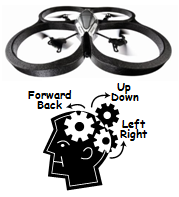Mind control of helicopters now. What might be next?
 In this amazing feat of engineering, a person’s thoughts are used to navigate a robot, which makes us wonder about other applications in the future.
In this amazing feat of engineering, a person’s thoughts are used to navigate a robot, which makes us wonder about other applications in the future.
Using a brain-computer interface developed by University of Minnesota biomedical engineering professor Bin He, several students learned to steer a robotic quadcopter with just their thoughts. As shown in the video, they navigated the craft around a gym, making it turn, rise, dip, and even sail through a ring.
Similar technology may someday allow disabled people to regain speech or mobility lost due to disease or injury. They may be able to control a variety of devices with just their thoughts, including lights, TV remotes, artificial limbs and wheelchairs. The solution is completely noninvasive: brain waves (EEG) are picked up by electrodes in a cap worn on the scalp, not requiring a chip implanted in the brain.
A more detailed report on the technology is available in the Journal of Neural Engineering, and the video is shown below.
RELATED ARTICLES:
The Evolution of Brain-Computer Interfaces – Imagine a world where machines can be controlled by thought alone. (INFOGRAPHIC)
The Cyborg in Us All (NY Times)
Young Innovators and The Future of Healthcare
First Human Brain-To-Brain Interface Lets Scientist Control Colleague’s Body (VIDEO)
COMMENT: Just as memories of the Brazilian lab rat were recorded and then transmitted to a rat at Duke, imagine the day when you can “plug in” to learn a new language or how to play an instrument or other applications of mind-machine and mind-mind interfaces. When will that occur? And will these capabilities be used for good or evil?
Imagine the implications of a $1,000 computer that becomes as powerful as the human brain (Ray Kurzweil projects that by 2037) or as powerful as the human race (2049) and how eventually that’s a $0.01 embedded processor that’s connected to trillions of similar processors in an Internet of Things, or dozens or thousands of cell-sized processors living in, and powered by, our bodies.
What will become of humans? After all, the biology of humans and other living organisms have evolved slowly – over many centuries – while tech innovation has evolved exponentially, following Moore’s Law. ‘Heady stuff (pun intended).

Machines can read your brain. There’s little that can stop them.
Technology is giving access to the inner workings of the brain, and policymakers are scrambling to regulate it.
https://www.politico.eu/article/machines-brain-neurotechnology-neuroscience-privacy-neurorights-protection/